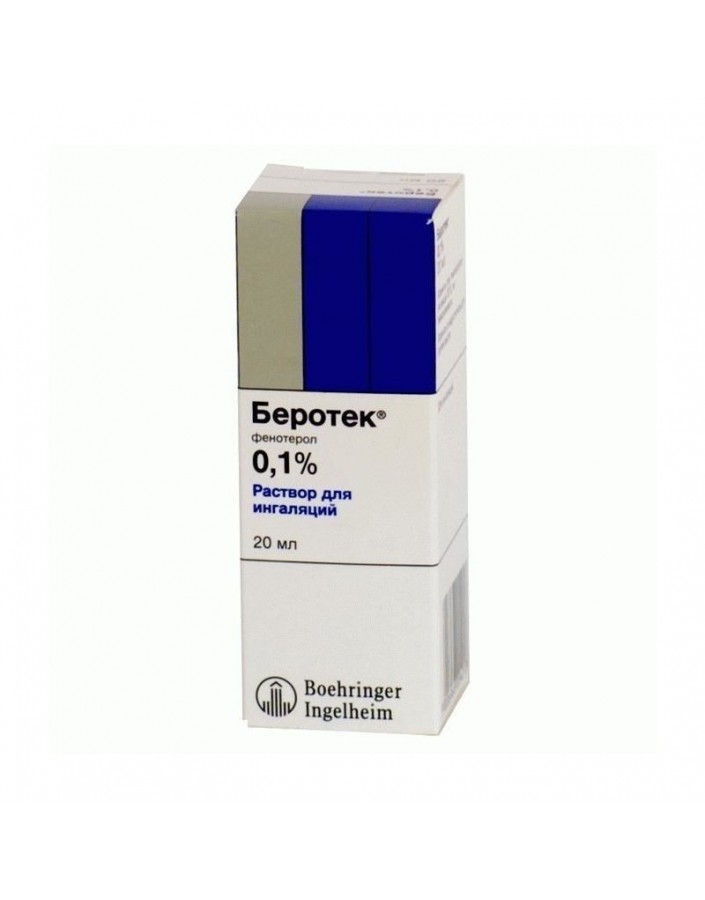




Security policy (edit with Customer reassurance module)

Delivery policy (edit with Customer reassurance module)

Return policy (edit with Customer reassurance module)
The selective beta2-adrenoreceptor stimulator activates adenylate cyclase with a subsequent increase in the formation of cAMP, which stimulates the Calcium pump that redistributes Ca2 + ions in myocytes, resulting in a decrease in the concentration of the latter in myofibrils. It has a powerful, rapidly advancing bronchodilator effect of medium duration of action. Warns and quickly eliminates bronchospasm of various origins. Fenoterol exhibits respiratory stimulant properties, increases the frequency and volume of respiration. Increases the activity of the ciliated epithelium of the bronchi. When administered parenterally, it has a tocolytic effect, causes relaxation of the myometrium through stimulation of beta2-adrenergic receptors. Removing the tension of the uterus and preventing its contractions, improves uteroplacental blood flow, increases the concentration of oxygen in the blood of the fetus. Virtually no effect on the CAS and internal organs. Onset of action after inhalation - after 5 minutes, maximum - 30-90 minutes, duration - 3-6 hours. The tocolytic effect develops 4 minutes after intravenous administration and lasts 11 minutes.
After oral administration, absorption is high. Intensively metabolized during the "first pass" through the liver. Excreted by the kidneys and with bile in the form of inactive sulfate conjugates. After inhalation, low concentrations are created in the blood.
Broncho-obstructive syndrome: bronchospasm during exercise, croup, COPD (including bronchial asthma); silicosis, bronchiectasis, tuberculosis. As a bronchodilator before inhalation of other drugs (antibiotics, mucolytic agents, GCS). Conducting bronchodilation tests in the study of respiratory function. The threat of premature birth, spontaneous miscarriage (starting at 16 weeks of gestation, after a sutured suture operation in case of cervical failure), complicated delivery during the opening of the cervix and expulsion of the fetus, and a decrease in the heart rate of the fetus associated with labor, for example, during entwining umbilical cord; fetal hypoxia, emergency obstetric conditions (cord prolapse, threatening uterine rupture); cesarean section (the need to relax the uterus).
Inhalation: for relief of acute suffocation in adults and children over 6 years old - 0.2 mg; for the prevention of asthma attacks - 0.2 mg, for adults - 3 times a day, for school-age children - 2 times a day, for children 4-6 years old - 0.1 mg, 4 times a day. If a single inhalation does not relieve an attack of breathlessness, then after 5 minutes it can be repeated. The next appointment is possible no earlier than after 3 hours. In / in a drip (in obstetrics and gynecology), the solution is prepared ex tempore, diluting in 5% dextrose, xylitol, 0.9% sodium chloride or Ringer's solution. Inject slowly, 0.5-3 mcg / min for 2-3 minutes (at a rate of 10 mcg / min) until the contractile activity of the uterus is inhibited; 15-30 minutes before the end of the IV infusion is prescribed by mouth, 5 mg every 3-6 hours; The maximum daily dose is 40 mg.
From the nervous system: minor tremor, dizziness, headache, nervousness, anxiety. On the part of the cardiovascular system: tachycardia, palpitations, angina pectoris pain, rarely (when using high doses) - a decrease in blood pressure, especially diastolic. On the part of the respiratory system: cough, rarely - paradoxical bronchospasm. On the part of the digestive system: nausea, belching, vomiting. Other: sweating, weakness, muscle pain and spasms, hypokalemia, hyperglycemia, weakening of the motility of the upper urinary tract, tolerance, rarely - allergic reactions. Overdose. Symptoms: tachycardia, palpitations, decrease or increase in blood pressure, increased pulse pressure, anginal pain, arrhythmias, flushing to the face, tremor. Treatment: the appointment of sedatives, tranquilizers, in severe cases - symptomatic therapy. Cardioselective beta-blockers are recommended as antidotes (atenolol, etc.).
Hypersensitivity. For parenteral administration - insufficiency and mitral valve stenosis, myocarditis, tachyarrhythmias, ventricular fibrillation, IHSS, myocardial infarction (acute stage), hypokalemia, thyrotoxicosis, WPW syndrome, glaucoma, bleeding during the placenta, premature discharge, premature marrow, glaucoma, premature discharge, premature heart failure, premature marrow fetal abnormalities of the fetus. For inhalation administration - with caution - IHSS, hyperthyroidism, arterial hypotension, arterial hypertension, intestinal atony, hypokalemia, diabetes mellitus, recent myocardial infarction, decompensated cardiovascular diseases, pheochromocytoma.
The increase in the total daily dose of the drug more than 12 breaths of the aerosol does not cause an additional therapeutic effect. With a / in the introduction of women in labor is necessary to monitor the ECG, pulse and blood pressure of the mother (before, during and after drug administration), for fetal heart rate. In patients with diabetes mellitus during treatment, it is necessary to regularly monitor plasma glucose.
Xanthine derivatives (theophylline), cromoglyceic acid, GCS, beta-adrenostimulyatory, MAO inhibitors, tricyclic antidepressants, anticholinergics, diuretics can enhance the effects, including side (especially with hypokalemia). Halogenated hydrocarbon agents for general anesthesia (halothane, trichlorethylene, enflurane) increase the effect on CVS. Beta-blockers significantly weaken the activity. The simultaneous appointment of bronchodilators with a similar mechanism of action leads to an additive effect and symptoms of overdose. Halothane sensitizes myocardium to the action of fenoterol, contributes to the development of arrhythmias.